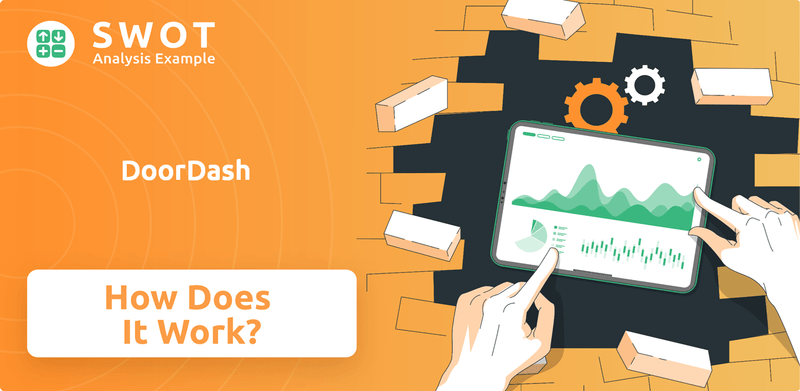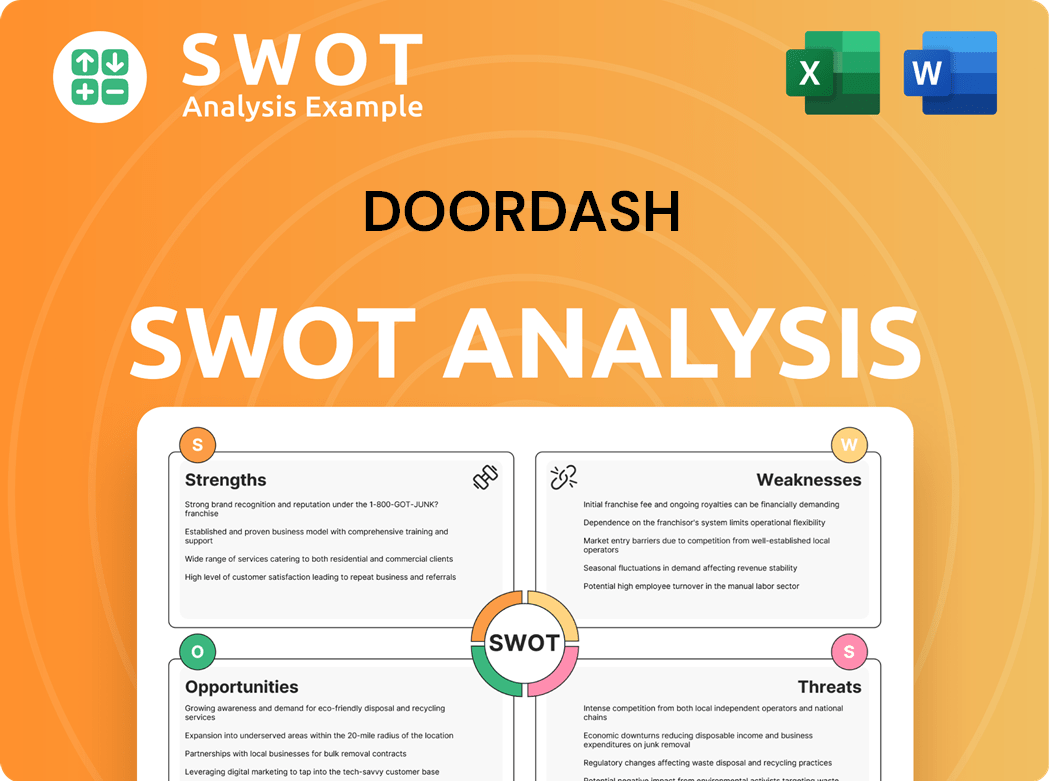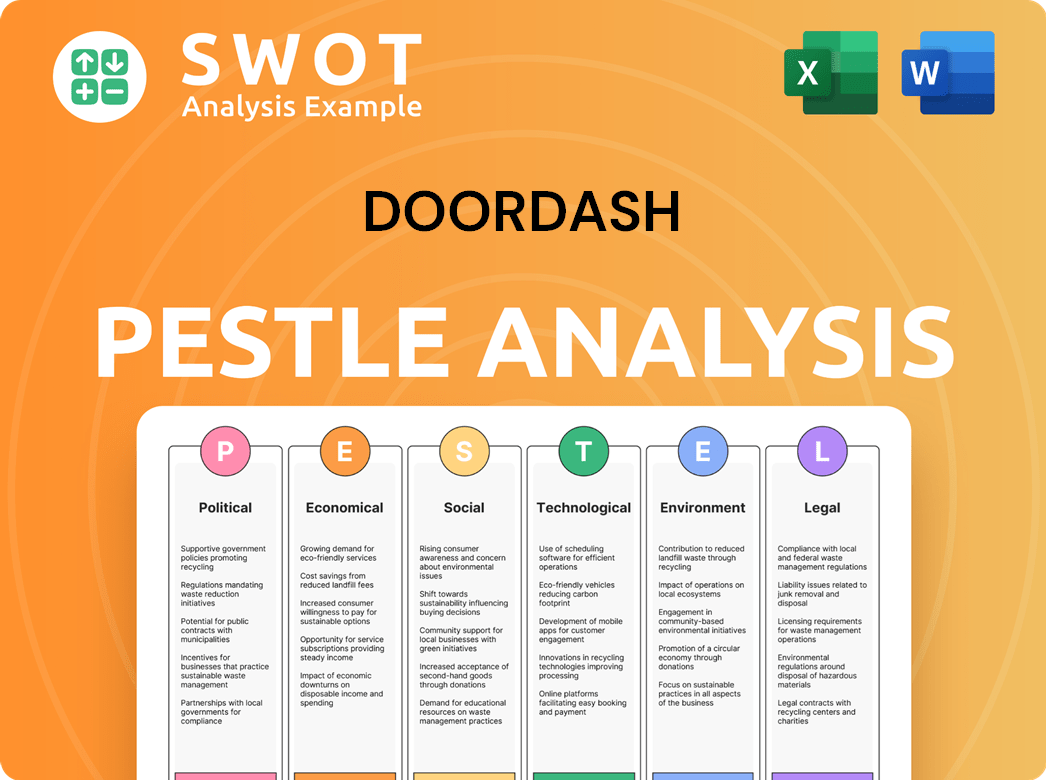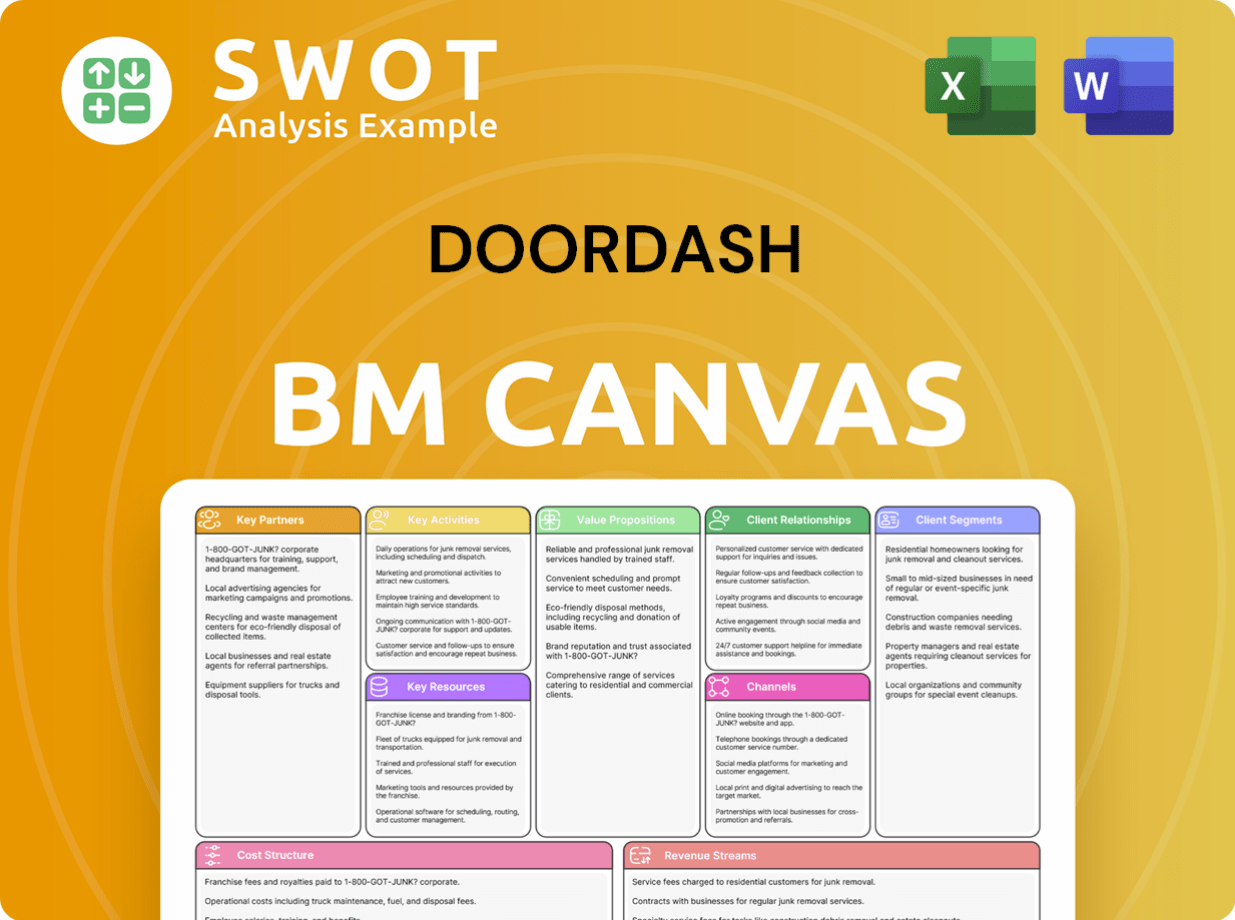DoorDash Bundle
How Does DoorDash Deliver Success?
DoorDash has revolutionized how we access local businesses, quickly becoming a leader in on-demand delivery. Its impressive market share and expanding services, especially in food and grocery, highlight its significant impact. This shift in consumer behavior, driven by convenience, has made DoorDash a vital partner for local businesses seeking a wider reach.

With operations spanning numerous cities and countries, DoorDash is evolving beyond just food delivery. Understanding DoorDash SWOT Analysis and its inner workings is crucial for investors, customers, and anyone tracking the gig economy. This analysis will explore the core operations, revenue strategies, competitive landscape, and future prospects of this powerful delivery app, providing a clear view of how DoorDash works and continues to thrive in a competitive market, offering insights into topics like DoorDash delivery time and DoorDash fees explained.
What Are the Key Operations Driving DoorDash’s Success?
The core of DoorDash's operations revolves around connecting customers with local businesses through a convenient and efficient delivery platform. This setup functions as a three-sided marketplace, involving customers, merchants (restaurants, grocery stores, and retailers), and Dashers (independent contractors who handle deliveries). This model allows DoorDash to offer a wide array of options to customers, while providing merchants with increased sales and expanded reach.
DoorDash's value proposition focuses on providing unparalleled convenience and access. Customers can order food, groceries, and other items for on-demand delivery. Merchants benefit from increased sales and access to a larger customer base. Dashers gain flexible earning opportunities. This system is supported by sophisticated technology that optimizes the entire process, from order placement to delivery.
The operational process begins when customers place orders via the DoorDash app or website. These orders are then sent to the respective merchants. Once the order is prepared, a nearby Dasher is dispatched to pick it up and deliver it. The company's technology uses algorithms for efficient order routing, Dasher dispatch, and estimated delivery times. This technology is central to minimizing delivery times and maximizing efficiency. DoorDash has expanded its services, including grocery and retail delivery, to meet evolving consumer needs.
Customers place orders through the DoorDash app or website, selecting from a variety of restaurants and stores. The platform offers a user-friendly interface for easy navigation and order customization. DoorDash provides options for scheduling deliveries and tracking orders in real time.
Once an order is placed, it's sent to the merchant for preparation. Merchants use the DoorDash platform to manage orders and prepare them for pickup. DoorDash provides tools to help merchants streamline their operations and manage customer orders efficiently.
A nearby Dasher is dispatched to pick up the order from the merchant and deliver it to the customer. DoorDash's platform uses algorithms to match Dashers with orders efficiently. Dashers use the DoorDash Driver app to manage deliveries and track earnings.
DoorDash's technology platform is crucial for efficient order routing and delivery times. The company continuously invests in technology development, such as DoorDash Drive, for white-label delivery solutions. This infrastructure supports the entire operation, from order placement to delivery.
DoorDash's supply chain is primarily digital, relying on its technological infrastructure and Dasher network. Partnerships with a wide range of restaurants and retailers are essential. The company's focus on technological innovation and a broad merchant network allows it to offer a differentiated service, benefiting customers with speed, choice, and convenience. For more insights, check out the Marketing Strategy of DoorDash.
- Order Management: Efficiently processes and routes orders to merchants and Dashers.
- Dasher Network: Manages and coordinates a large network of independent contractors.
- Merchant Partnerships: Collaborates with restaurants, grocery stores, and retailers.
- Technology Platform: Utilizes algorithms for order routing, dispatch, and delivery time estimation.
DoorDash SWOT Analysis
- Complete SWOT Breakdown
- Fully Customizable
- Editable in Excel & Word
- Professional Formatting
- Investor-Ready Format

How Does DoorDash Make Money?
The core of how DoorDash works revolves around its multifaceted revenue streams and monetization strategies. The company has successfully built a robust financial model by leveraging commissions, delivery fees, and advertising. These strategies enable the platform to adapt to market demands and maintain strong financial performance.
DoorDash's financial success is driven by a combination of direct charges to both merchants and customers, alongside innovative services. This approach has allowed it to establish a significant presence in the food delivery service market and expand into other areas like grocery and convenience store deliveries. Understanding these revenue streams is key to grasping the overall business model.
DoorDash's primary revenue sources are commissions from merchants, delivery fees from customers, and advertising services. Commission rates, which usually range from 15% to 30%, are charged to merchants based on the order value. Delivery fees vary depending on factors such as distance and demand, and they are charged directly to customers. Advertising services offer merchants increased visibility on the platform.
DoorDash employs multiple strategies to generate revenue, ensuring a diversified financial model. These strategies include a subscription service, advertising, and logistics services. These diverse revenue streams contribute to the company's financial health and market adaptability.
- Commissions: Merchants are charged a percentage of the order value, typically between 15% and 30%, for using the DoorDash platform.
- Delivery Fees: Customers pay fees that vary based on distance, demand, and merchant partnerships for each order placed through the DoorDash delivery app.
- DashPass: This subscription service provides subscribers with unlimited eligible deliveries with $0 delivery fees and reduced service fees for a monthly or annual fee. As of the first quarter of 2024, DashPass had 15 million members.
- Advertising: Merchants can pay for promotional tools and sponsored listings to increase their visibility on the platform. In 2023, advertising revenue reached $973 million.
- DoorDash Drive: This service offers last-mile logistics to businesses.
- Grocery and Convenience Store Delivery: Expanding into these areas provides additional revenue streams.
The success of DoorDash delivery is also influenced by its strategic partnerships and operational efficiency. To learn more about their growth strategy, you can read about the Growth Strategy of DoorDash.
DoorDash PESTLE Analysis
- Covers All 6 PESTLE Categories
- No Research Needed – Save Hours of Work
- Built by Experts, Trusted by Consultants
- Instant Download, Ready to Use
- 100% Editable, Fully Customizable

Which Strategic Decisions Have Shaped DoorDash’s Business Model?
The journey of DoorDash has been marked by significant milestones and strategic decisions that have shaped its market position. Initially, the company focused on suburban and smaller markets, often overlooked by competitors, which allowed it to establish a strong presence. Diversification beyond restaurant delivery into groceries, convenience items, and alcohol was a crucial move, broadening its market and reducing reliance on a single category. These strategic shifts have been instrumental in its growth and competitive positioning within the food delivery service industry.
A major strategic move was the acquisition of Wolt in 2022 for approximately €7 billion, significantly expanding DoorDash's international footprint, particularly in Europe. This acquisition was aimed at accelerating global growth and leveraging Wolt's operational expertise in new markets. DoorDash has continuously adapted its strategies to meet evolving consumer demands and expand its service offerings, demonstrating its commitment to innovation and market leadership. The company's ability to adapt and expand its services has been key to sustaining its competitive edge.
Operational challenges have included managing the logistics of a rapidly expanding network of Dashers and merchants, especially during periods of high demand or unforeseen events. Regulatory hurdles surrounding the classification of gig workers and commission caps in certain cities have also presented ongoing challenges, requiring DoorDash to adapt its business practices and engage in policy discussions. Despite these challenges, DoorDash has maintained a strong focus on growth and innovation.
DoorDash's early focus on suburban and smaller markets allowed it to gain a strong foothold. The expansion beyond restaurant delivery into groceries, convenience items, and alcohol marked a crucial diversification strategy. The acquisition of Wolt in 2022 significantly expanded its international presence, particularly in Europe.
Diversification into new delivery categories broadened its addressable market. The acquisition of Wolt aimed to accelerate global growth. Continuous investment in product innovation helps maintain customer loyalty and merchant engagement. These moves have been pivotal in shaping DoorDash's competitive landscape.
Strong brand recognition and extensive network effects create a powerful cycle. Proprietary technology, particularly its logistics algorithms, provides an operational edge. Continuous investment in product innovation helps maintain customer loyalty. Adapting to changing consumer preferences has been key to sustaining its competitive edge.
Managing the logistics of a rapidly expanding network of Dashers and merchants is a key challenge. Regulatory hurdles, such as gig worker classification and commission caps, present ongoing issues. Adapting business practices and engaging in policy discussions are necessary. These challenges require DoorDash to remain agile and responsive.
DoorDash's competitive advantages are multifaceted, including strong brand recognition and extensive network effects. Its proprietary technology, particularly its sophisticated logistics algorithms, provides an operational edge. The company's ability to adapt to changing consumer preferences and strategically expand its global footprint has been key to sustaining its competitive edge. For a deeper dive into the competitive landscape, consider exploring the Competitors Landscape of DoorDash.
- Strong brand recognition and network effects.
- Proprietary technology and logistics algorithms.
- Continuous investment in product innovation.
- Adaptability to changing consumer preferences.
DoorDash Business Model Canvas
- Complete 9-Block Business Model Canvas
- Effortlessly Communicate Your Business Strategy
- Investor-Ready BMC Format
- 100% Editable and Customizable
- Clear and Structured Layout

How Is DoorDash Positioning Itself for Continued Success?
In the realm of food delivery, DoorDash has firmly established itself as a dominant force, particularly in the U.S. market. Its operational model and strategic initiatives have fueled significant growth. The company's ability to adapt and expand into various delivery sectors highlights its ambition to become a comprehensive local commerce platform.
However, DoorDash faces several challenges, including regulatory risks and intense competition. These factors, coupled with the need to maintain profitability, shape the company's strategic approach. The future trajectory of DoorDash hinges on its capacity to innovate, expand its services, and navigate the complexities of the delivery market.
DoorDash currently holds a significant market share in the U.S. food delivery sector. As of early 2024, it controlled approximately 67% of the market. This strong position is supported by a vast network of consumers and merchants, as well as its expansion into international markets, particularly following the Wolt acquisition.
Key risks include regulatory changes affecting gig workers, which could impact labor costs and operational models. Competition from Uber Eats and Grubhub, along with emerging local services, demands constant innovation. Economic downturns and shifts in consumer spending could also affect order volumes. Technological disruptions and cybersecurity threats pose additional challenges.
The future outlook for DoorDash involves expanding into new verticals beyond restaurants, such as grocery and retail delivery. Strategic initiatives include investing in automation and robotics for last-mile delivery. The company also aims to enhance its logistics technology and expand its DashPass subscription service to drive customer retention.
DoorDash is focused on driving efficiency, improving the experience for its delivery personnel, and providing more value to merchants and customers. The company aims to deepen its global footprint and explore partnerships to broaden its merchant selection. These efforts are geared towards sustaining revenue growth and achieving long-term profitability. Read more about the Growth Strategy of DoorDash to understand its expansion plans.
DoorDash's performance is closely watched by investors and analysts. The company's ability to maintain its market share and improve profitability are crucial for its long-term success. Key metrics include order volume, revenue per order, and customer acquisition cost.
- Market Share: Maintaining a dominant market share in the U.S. food delivery market, currently around 67%.
- Revenue Growth: Expanding revenue through increased order volume and new service offerings.
- Profitability: Improving operational efficiency and achieving sustained profitability, especially in international markets.
- Customer Retention: Enhancing customer loyalty through the DashPass subscription service and other initiatives.
DoorDash Porter's Five Forces Analysis
- Covers All 5 Competitive Forces in Detail
- Structured for Consultants, Students, and Founders
- 100% Editable in Microsoft Word & Excel
- Instant Digital Download – Use Immediately
- Compatible with Mac & PC – Fully Unlocked

Related Blogs
- What are Mission Vision & Core Values of DoorDash Company?
- What is Competitive Landscape of DoorDash Company?
- What is Growth Strategy and Future Prospects of DoorDash Company?
- What is Sales and Marketing Strategy of DoorDash Company?
- What is Brief History of DoorDash Company?
- Who Owns DoorDash Company?
- What is Customer Demographics and Target Market of DoorDash Company?
Disclaimer
All information, articles, and product details provided on this website are for general informational and educational purposes only. We do not claim any ownership over, nor do we intend to infringe upon, any trademarks, copyrights, logos, brand names, or other intellectual property mentioned or depicted on this site. Such intellectual property remains the property of its respective owners, and any references here are made solely for identification or informational purposes, without implying any affiliation, endorsement, or partnership.
We make no representations or warranties, express or implied, regarding the accuracy, completeness, or suitability of any content or products presented. Nothing on this website should be construed as legal, tax, investment, financial, medical, or other professional advice. In addition, no part of this site—including articles or product references—constitutes a solicitation, recommendation, endorsement, advertisement, or offer to buy or sell any securities, franchises, or other financial instruments, particularly in jurisdictions where such activity would be unlawful.
All content is of a general nature and may not address the specific circumstances of any individual or entity. It is not a substitute for professional advice or services. Any actions you take based on the information provided here are strictly at your own risk. You accept full responsibility for any decisions or outcomes arising from your use of this website and agree to release us from any liability in connection with your use of, or reliance upon, the content or products found herein.